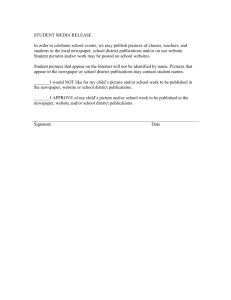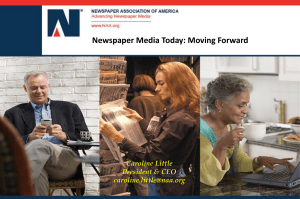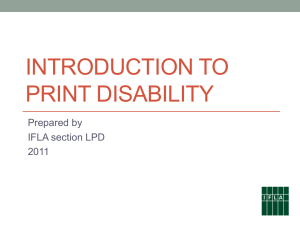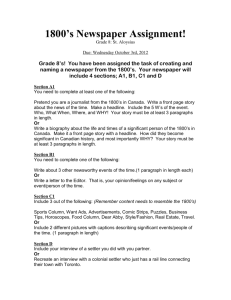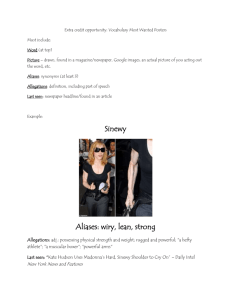Extra, Extra, Read All About It
advertisement
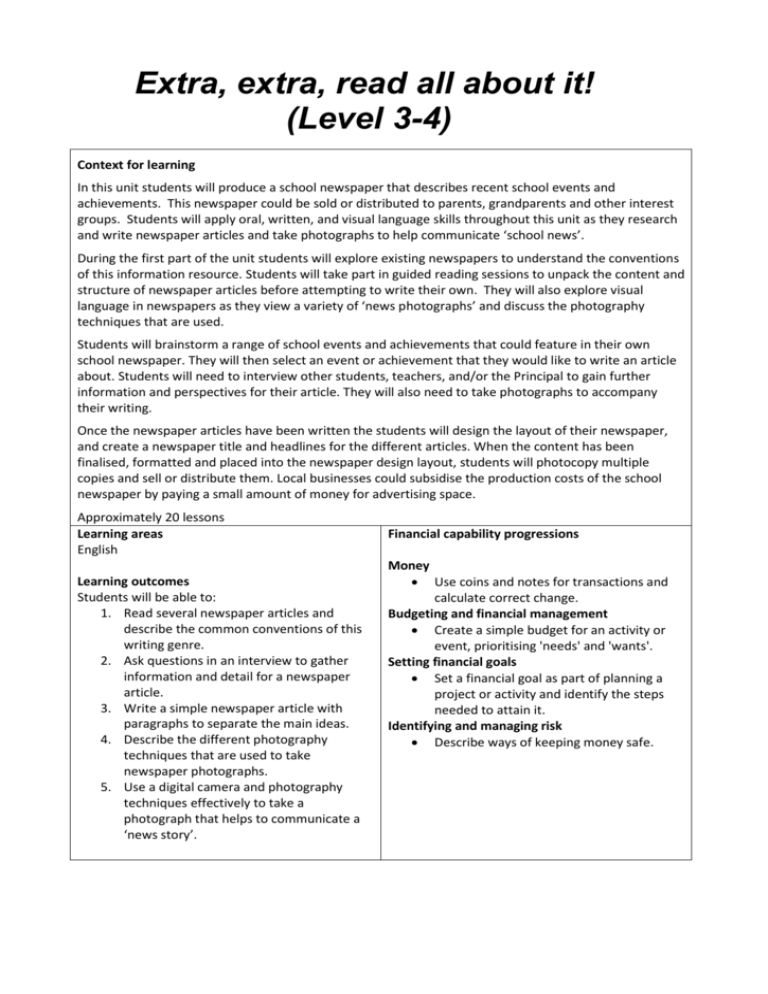
Extra, extra, read all about it! (Level 3-4) Context for learning In this unit students will produce a school newspaper that describes recent school events and achievements. This newspaper could be sold or distributed to parents, grandparents and other interest groups. Students will apply oral, written, and visual language skills throughout this unit as they research and write newspaper articles and take photographs to help communicate ‘school news’. During the first part of the unit students will explore existing newspapers to understand the conventions of this information resource. Students will take part in guided reading sessions to unpack the content and structure of newspaper articles before attempting to write their own. They will also explore visual language in newspapers as they view a variety of ‘news photographs’ and discuss the photography techniques that are used. Students will brainstorm a range of school events and achievements that could feature in their own school newspaper. They will then select an event or achievement that they would like to write an article about. Students will need to interview other students, teachers, and/or the Principal to gain further information and perspectives for their article. They will also need to take photographs to accompany their writing. Once the newspaper articles have been written the students will design the layout of their newspaper, and create a newspaper title and headlines for the different articles. When the content has been finalised, formatted and placed into the newspaper design layout, students will photocopy multiple copies and sell or distribute them. Local businesses could subsidise the production costs of the school newspaper by paying a small amount of money for advertising space. Approximately 20 lessons Learning areas English Learning outcomes Students will be able to: 1. Read several newspaper articles and describe the common conventions of this writing genre. 2. Ask questions in an interview to gather information and detail for a newspaper article. 3. Write a simple newspaper article with paragraphs to separate the main ideas. 4. Describe the different photography techniques that are used to take newspaper photographs. 5. Use a digital camera and photography techniques effectively to take a photograph that helps to communicate a ‘news story’. Financial capability progressions Money Use coins and notes for transactions and calculate correct change. Budgeting and financial management Create a simple budget for an activity or event, prioritising 'needs' and 'wants'. Setting financial goals Set a financial goal as part of planning a project or activity and identify the steps needed to attain it. Identifying and managing risk Describe ways of keeping money safe. Key competencies Thinking Collecting, organising and analysing information Generating, identifying and assessing opportunities. Identifying, assessing and managing risks. Participating and contributing Planning and organising Working with others and in teams. Using language, symbols and texts Communicating and receiving ideas and information. Values Integrity Appreciating the need for honest transactions and records. Excellence Setting financial goals and achieving them. Innovation, inquiry and curiosity Thinking creatively, critically, and reflectively to: set and achieve personal financial goals analyse and solve financial problems. Community Sharing resources, knowledge, skills. Resource requirements A variety of newspapers Members of the school community NiE coordinator for your area – see www.southland.co.nz/businesses/national/nie.htm Websites on photography techniques – see www.photographytips.com and www.dmoz.org/Arts/Photography/Techniques Local businesses Photocopier Teaching and learning NB: Teachers are encouraged to gauge the prior knowledge of their students before implementing each unit so that they can provide personalised and meaningful learning opportunities. The teaching and learning sequence provided in each unit is to be viewed as a guide only. Teachers will need to adapt this sequence to meet the needs of their students, school, and community. The future focused issues of citizenship and enterprise can be explored during this unit. In being enterprising by producing then distributing or selling this newspaper, students are contributing to the well being of people in their community. Newspapers and other mediums for broadcasting information about our community are part of keeping citizens informed and engaged in their community. Some newspapers are sold for profit, while others are community funded. Advertising also funds news broadcasting. The numbered activities listed below are learning steps rather than lessons. Teachers may choose to combine two or three learning steps into one lesson. Alternatively, they may spread one learning step out over several lessons. This will be largely dependent on students’ prior knowledge and their subsequent learning needs. Getting started 1. The teacher reads the journal story “Class Newspaper” (School Journal Part 4, Number 2, 2003) to the class. The teacher then explains to the class that they are going to produce their own school newspaper that they will distribute or sell to parents, grandparents and friends of the school. 2. The class creates a timeline for the unit with key dates for critical actions. This process will make the teaching sequence of the unit explicit to the students. Teaching and learning sequence 3. The teacher and students explore the following questions: What is a newspaper? Who reads newspapers? What do newspapers look like? What information is contained in them? Etc. Record responses on a class brainstorm. (Teachers note that newspapers today can be in electronic or print format.) 4. Students brainstorm the range of jobs they think will need to be done to produce their newspaper, 5. and to ensure it is published by the ‘due’ date. Students discuss and describe the roles all students will be engaged in, and other jobs that could be allocated to students who have a specialist skill or interest. This will encourage students to think about the steps and processes they will be engaged in to complete this unit. Students take a closer look at newspapers by completing a treasure hunt. The hunt requires students to locate different components of a newspaper such as: a coloured photograph, a black and white photograph, a headline, contents column, weather report, masthead (newspaper title), a NZ story, a world story, a sports story, an advertisement, etc. Discuss with the students where each item was found and why each item is included in the newspaper – is there a typical way of setting out a newspaper? 6. Students begin to design/shape their own school newspaper by discussing the following questions: What could our newspaper be called? What school stories could be told inside the newspaper? List all ideas on a poster. 7. Over the next series of lessons the teacher runs several guided reading sessions to allow students to examine a newspaper article in closer depth. The teacher selects a newspaper article that will be of interest to the students. The teacher breaks the article into chunks for analysis. What information is recorded in the first paragraph? What information is recorded in the next paragraphs? Why are paragraphs used? What does the headline say? Is this headline interesting and informative? Are there any speech-marks in the newspaper article? Why are the speech-marks used? Does the newspaper article answer the 5 Ws – Who? What? When? Where? Why? Etc. Repeat this process for other newspaper articles. (Learning outcome 1) The teacher and students write a newspaper article about a class event in a modelled writing session. The teacher and students plan their article first by brainstorming important points of the ‘news story’ and ensuring that the 5 Ws will be explained to the reader. The teacher records the newspaper article onto a big poster using different coloured pens for the different components of the writing. The teacher emphasises the use of paragraphs. (Learning outcome 3) 8. The teacher and students list a set of “success criteria” for an effective newspaper article. The success criteria should focus on the written content of the article and could include the following… An effective newspaper article … has a interesting and informative headline summarises what the article is about within the first paragraph to orientate the reader explains when and where the event/achievement happened explains who was involved in the event/achievement and why the event/achievement took place includes quotations to give human perspectives on the story uses paragraphs to separate key ideas/points; etc. (LO 3) 9. The teacher and students re-visit the writing that they created at step 8 to check that it meets the success criteria. Edit the writing if necessary. (LO 3) 10. Students look at the list of ‘news stories’ that they created at step 6 and add any further ideas for their school newspaper. Students select a ‘news story’ that they would like to write about. Students may decide to work with a buddy to write the article or they may choose to work independently. (LO 3) 11. Students list the information that they already know about their selected ‘news story’. They also list questions that they need to ask to gain more detail about the event or achievement. (Learning Outcome 2) 12. Students identify and interview key people for their ‘news story’ to gain further information and perspectives for their article. (LO 2) 13. Students plan their writing by brainstorming the key points of the story and ensuring that the 5 Ws will be explained to the reader. (Learning Outcome 3) 14. Students write and edit their newspaper article using the writing model created at step 6 and the success criteria created at step 7 for guidance. The teacher regularly conferences with students to ensure that they can overcome any problems, enhance their writing, and experience success. (LO 3) 15. Invite a ‘Newspapers in Education’ (NiE) Coordinator to visit the school to talk to the students about news photography. Ask that the NiE Coordinator introduces photography techniques/concepts such as: ANGLE - up, down, straight DISTANCE – close, medium, far LEVEL – eye level, high, low PANNING – right, left, forwards FRAMING – subject, shapes, space, composition Also ask that the NiE Coordinator shows the students a range of news photographs that demonstrate the different techniques. Encourage the students to consider and discuss the effectiveness of each photograph and to begin exploring what type of photograph they want to take for their ‘news story’. (Learning Outcome 4) 16. Students brainstorm several ‘photo ideas’ for their news story. They discuss their ideas with a peer and/or the teacher and consider which ideas are the most feasible, creative and relevant. (Learning Outcome 5) 17. Students use the digital camera to take several photographs for their article. They then load the photographs onto the computer and select the ‘best shot’. Students may ask for feedback about their photograph choices before making a final decision. (LO 5) 18. Over the next series of lessons the teacher and students spend time organising the design layout of their school newspaper ending with their final ‘copy’. A masthead (newspaper title) will need to be created, a contents column will need to written, articles will need to be published and photographs will need to be appropriately sized and placed. Local businesses could be invited to place advertisements in the school newspaper for a small sum of money. This money could go towards publishing costs. Students could be assigned different roles in the production stage of the newspaper such as overall editor, advertising managers, masthead designer, etc. NB: It may be useful to call upon the school secretary for assistance in the publishing process. They could have some handy tips and may even want to share their expertise during a lesson. 19. Once the newspaper copy is finalised the students can photocopy and compile multiple copies for distribution. 20. The newspaper could be officially launched at a school assembly before it is distributed or sold to parents, grandparents and other interest groups. Reflective questions Exploring new knowledge and skills What information is contained in a newspaper? What do you need to remember when you write an article for a newspaper? Did your newspaper article meet the shared success criteria? What different photography techniques can you consider when taking a photograph? What photography technique/s did you use and why? Did people like your newspaper? Would you make any changes to the school newspaper if you could? Who pays in our community for the cost of our newspapers? Exploring what it is to be innovative and enterprising What step/s were you doing when you used each of the Enterprising Attributes? Break each attribute into its separate words and refine your answers. How could you improve on using the Enterprising Attribute/s for next time? Can you transfer this learning to your other topics? Exploring further future focus issues Describe the benefits of broadcasting community news. How might the medium for broadcasting news change over time, e.g. digital? What might be some of the negative consequences if news is not available to people? In your school? Local community? What values did you apply in this learning? Did that help to make it a success? Possible assessment activities (Teacher) Learning outcome 3: Teacher assesses students’ newspaper articles against shared success criteria. The teacher may choose to use English Exemplars to help gauge curriculum level of writing. Learning outcome 4: Teacher distributes several newspaper photographs and asks students to comment on the photography techniques that are used. Learning outcome 5: Students and teacher evaluate the photograph that was selected for the newspaper article. Does the photograph help to convey the news story? Can the student justify why they selected that particular photo for the school newspaper? Has the student controlled the camera and used photography techniques effectively?

